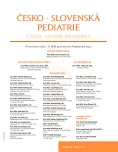Pseudo-Bartter syndrome as the first manifestation of cystic fibrosis
Authors:
V. Urbanová; A. Feketeová; Ľ. Podracká
Authors‘ workplace:
Klinika detí a dorastu LF UPJŠ a DFN, Košice
Published in:
Čes-slov Pediat 2015; 70 (1): 29-32.
Category:
Case Report
Overview
Pseudo-Bartter syndrome is a rare but well known complication of cystic fibrosis characterized by hypochloremic hypokaliemic metabolic alkalosis. The authors describe an interesting case of a 3-month infant with negative newborn screening presented by severe acid-base and electrolytes disturbances, which led us to suspicion of the diagnosis of cystic fibrosis. Molecular-genetic testing identified both mutations of the CFTR gene (F508del/Glu831X). Remarkable is, that our patient is the first gypsy child with cystic fibrosis in Slovakia. In the searching for the cause of hypochloremic alkalosis, it is necessary to exclude cystic fibrosis also in infants with negative newborn screening.
Key words:
hypochloremic metabolic alkalosis, cystic fibrosis, newborn screening
Sources
1. Hill CM. Practical Guidelines for Cystic Fibrosis Care. Edinburgh, Scotland: Churchill Livingstone, 1998: 13–18.
2. Dahabren MM, Najada AS. Pseudo-Bartter syndrome, pattern and correlation with other cystic fibrosis features. Saudi J Kidney Dis Transpl 2013; 24 (2): 292–296.
3. Kose M, Pekcan S, Ozcelik U. An epidemic of pseudo-Bartter syndrome in cystic fibrosis patients. Eur J Pediatr 2008; 167: 115–116.
4. Yalcin E, Kiper N, Dogru D, et al. Clinical features and treatment approaches in cystic fibrosis with pseudo-Bartter syndrome. Ann Trop Paediatr 2005; 25: 119–124.
5. Kintu B, Brightwell A. Episodic seasonal pseudo-Bartter syndrome in cystic fibrosis. Paediatr Respir Rev 2014; S1: 19–21.
6. Scurati-Manzoni E, Fossali E F, Agostoni C. Electrolyte abnormalities in cystic fibrosis: systemic review of the literature. Pediatr Nephrol 2014; 29: 1015–1023.
7. Stenvinkel P, Hjelte L, Alván G, et al. Decreased renal clearance of sodium in cystic fibrosis. Acta Paediatr Scand 1991; 80: 194– 198.
8. Doležel Z, Kopečná L. Pseudo-Bartter syndrome as a presentation of cystic fibrosis. Pediatric Nephrology 1999; 13: P27.
9. Dugueperoux I, De Braekeleer M. The CFTR 3849+10kb- C>T and 2789+5G>A alleles are associated with a mild CF phenotype. Eur Respir J 2005; 25: 468–473.
10. Egritas O, Dalgic B, Wedenoja S. Congenital chloride diarrhea misdiagnosed as Bartter syndrome. Turk J Gastroenterol 2011; 22: 321–323.
11. Horvatovich K, Orkenyi M, Biro E, et al. Pseudo-Bartter syndrome in a case of cystic fibrosis caused by C1529G and G3978A compound heterozygosity. Orv Hetil 2008; 149: 325–328.
12. Kennedy JD, Dinwiddie R, Daman-Willems C, et al. Pseudo-Bartter‘s syndrome in cystic fibrosis. Arch Dis Child 1990; 65: 786–787.
13. Marah MA. Pseudo-Bartter as an initial presentation of cystic fibrosis: A case report and review of the literature. EMHJ 2010; 16 (6): 699–701.
14. Nahida el-R, Mohammed H, Guy L. Pseudo-Bartter‘s syndrome revealing cystic fibrosis in an infant caused by 3849 +1G>A and 4382del A compound heterozygosity. Acta Paediatr 2011; 100: 234–235.
15. Salvatore D, Tomaiuolo R, Abate R, et al. Cystic fibrosis presenting as metabolic alkalosis in a boy with the rare D579G mutation. J Cyst Fibros 2004; 3 (2): 135–136.
16. Dluholucký S, Knapková M. Ročná správa novorodeneckého skríningu za rok 2013. Skríningové centrum novorodencov SR, Detská fakultná nemocnica s poliklinikou, Banská Bystrica.
17. Kovács L, Hlavatá K, Jankó V. Pseudo-Bartterov syndróm u dojčaťa s falošne negatívnym výsledkom skríningu na cystickú fibrózu. Pediatr prax 2012; 13 (6): 266–267.
Labels
Neonatology Paediatrics General practitioner for children and adolescentsArticle was published in
Czech-Slovak Pediatrics

2015 Issue 1
Most read in this issue
- Rhabdomyolysis after heavy physical exercise at the fithess center
- Primary Care Paediatricians (PCP) and their options in providing services to newborns, infants, children and adolescent patients
- Renal cysts and diabetes syndrome
- Malignant tumours of thyroid gland in children
